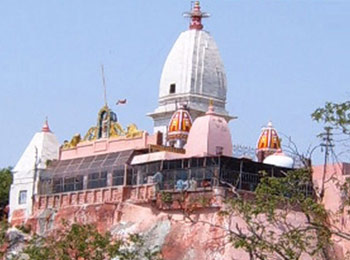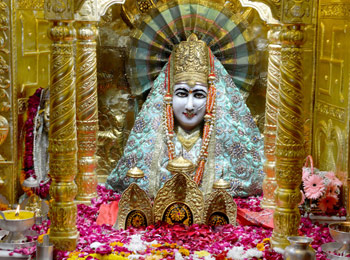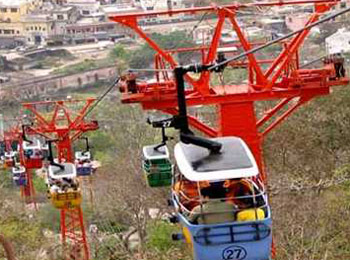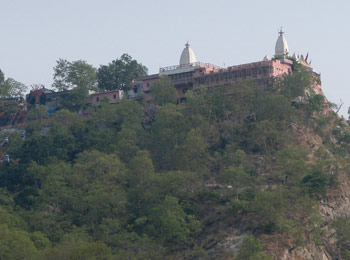- Shakti
Mansa Mata Mandir
- Bilaspur,Haryana
- View on map
- Tell us about this temple
Overview
Mata Mansa Devi Temple at Panchkula is a symbol of Himalayan culture and faith. The shrine located on the foot hills of Shivalik is an epitome of age old tradition of ‘Shakti’ worship in northern India. Himalaya being the abode of Shiva and his consort ‘shakti’ became centre of shakti worship. In the vicinity of Panchkula there are numerous Shakti worshipping centers known by their names such as Chandi, Kalika, Mansa, Bhima etc. Hence, mythological speaking, Chandigarh-Panchkula region undoubtedly continued to be living legends of shaktism where its practices are in vogue. However, the present temple which stands a witness to the exciting past of the Shivalik region is about two hundred years old.
The archeological treasures unearthed from Chandigarh-Panchkula region throw eloquent light on the history and culture of the area from the prehistoric to the recent times. Although owing to the onslaught of times and climes many tangible realities of the cultural manifestations of the region have been lost in the oblivion, yet there are certain things which never die out. One such reality is the Mansa Devi Shrine and the tradition of shaktism practiced in this part of the country, where the past has been rejuvenated for sustaining one of the living traditions of shaktism in India.
About The Temple

Two temples are located in the complex of Mansa Devi. The main temple is dedicated to Mansa who is worshipped in the sanctum sanctorum both in the form of ‘pindi’ as well as in her anthropomorphic form executed on a marble. In the sanctum sanctorum she is worshipped with Devi Saraswati and Lakshmi in the form of Pindi (Stone pebbles). Originally the pindis were only worshipped by the devotees. However, in modern times a marble bust of the deity was got sculpted for giving an attractive human look (form) to the deity. She is beautifully decorated with crown and other ornaments.
Interestingly the architecture of the main temple (Mansa Devi) is not in consonance with the Shivalik region where usually a typical ‘Nagara’ or curvilinear spira temples were erected. This is in sharp contrast to the environment of the region as the main temple manifests a typical mogul architecture represented by domes and minarets.
Architecturally speaking the temple has been built in Panchayatana pattern in which at four cardinal corners stand four shrines with the main shrine (fifth shrine) being located the centre.All the five temples show four minarets at four corners with a cupola on its top. The domes are onion shaped and stand on an elongated circulator drum. The facade of the temple shows miniature vaulted alcoves.
In sharp contrast to the Mansa Devi temple, Patiala temple has a typical ‘ nagara’ curvelinear spire with miniature shrines decorated on its body from bottom to top of the spire. This architectural a style definitely goes in consonance with the shivalik background. The colossal temple is built in pancharatha style with four projections or transected parts on its four sides bearing semi pyramidal conical spires on the tops. These are called 'shikkars' or cronical shapes on the main domes.
In the sanctorum the Devi is worshipped in its anthropomorphic form sculpted on marble. The bust is enshrined in a silver plated small vaulted shrine showing a beautiful decoration of silver embossing works throughout the body of the miniature vaulted shrine. Here also the pindi (stone) is worshipped along with the marble bust.
The architecture of the main temple has mughal features but this temple has a covered 'Parikarma', which is a salient feature of Hindu art and architecture. Patiala temple on the other hand has Hindu features in its architecture, but it has an open Parikarma, which is in marked departure from the traditional Hindu architecture.Mansa Devi Temple is an ancient temple that attracts people from both far and near due to its significance.The temple is considered a must visit for the pilgrims going to Haridwar. It enhances the holy tradition of Haridwar which persists in the place from many past centuries. It offers views of the River Ganges and the plains of Haridwar.
To reach the shrine one has to either follow the trekking route up to this holy shrine or ride on the recently introduced rope-way service. The rope-way service known as "Mansa Devi Udankhatola" was introduced for the benefit of the pilgrims and it caters to the pilgrims also to the nearby located Chandi Devi shrine. The rope-way carries the pilgrims from the lower station directly to the Mansa Devi Temple. The total length of the rope-way is 540 metres (1,770 ft) and the height it covers is 178 metres (584 ft). On a normal day, the temple is open between 8 am and 5 pm, except for lunch closings of 12 pm to 2 pm.
This temple along with the nearby located Chandi Devi temple is visited by thousands of devotees from various parts of the country, and especially during the Navratra and the Kumbha Mela in Haridwar.
It is said that goddesses Mansa and Chandi, the two forms of goddess Parvati always reside close to each other. This belief can also be found true in other case since near to the Mata Mansa Devi Mandir in Panchkula, Haryana, there is a Chandi Mandir located nearby in Chandigarh.
About The Deity

The Mansa Devi Temple, Haridwar is dedicated to Goddess Mansa Devi in Haridwar in Uttarakhand. The temple is located atop the Bilwa Parvat on the Sivalik Hills, the southernmost mountain chain of the Himalayas. The temple also known as Bilwa Tirth is one of the Panch Tirth (Five Pilgrimages) within Haridwar. The temple is known for being the holy abode of Manasa, a form of Shakti and is said to have emerged from the mind of the lord Shiva. Mansa is regarded as the sister of the N?ga (serpent) Vasuki. The term Mansa means wish and it is believed that the goddess fulfils all the wishes of a sincere devotee. Devotees who want their wishes to be fulfilled by Mansa tie threads to the branches of a tree located in the temple. Once their wishes are fulfilled, people come back again to the temple to untie the thread from the tree. Mansa is also offered coconuts, fruits, garlands and incense sticks in order to appease her.
Mansa Devi Temple is a Siddh Peetha which is the place of worship where desires get fulfilled. It is one of three such Peethas located in Haridwar, the other two being Chandi Devi Temple and Maya Devi Temple. The inner shrine has two deities installed, one with eight arms and the other one three headed with five arms. Manasa, also Mansa Devi, is a Hindu folk goddess of snakes, worshipped mainly in Bengal and other parts of North and northeastern India, chiefly for the prevention and cure of snakebite and also for fertility and prosperity. Manasa is the sister of Vasuki, king of Nagas (snakes) and wife of sage Jagatkaru (Jaratkaru). She is also known as Vishahara (the destroyer of poison), Nitya (eternal) and Padmavati.
Her myths emphasize her bad temper and unhappiness, due to rejection by her father Shiva and her husband, and the hatred of her stepmother, Chandi (Shiva's wife, identified with Parvati in this context). In some scriptures, sage Kashyapa is considered to be her father, rather than Shiva. Manasa is depicted as kind to her devotees, but harsh to people who refused to worship her. Denied full godhead by her mixed parentage, Manasa’s aim was to fully establish her authority as a goddess and to acquire steadfast human devotees. Manasa first appears in the Hindu text Atharva Veda as a snake goddess. In the Puranas, she was recognized as a daughter of sage Kashyapa and Kadru, the mother of all Nagas. By the 14th century, Manasa was identified as the goddess of fertility and marriage rites and was assimilated into the Shaiva pantheon as a relative of Shiva. Myths glorified her by describing that she saved Shiva after he drank poison, and venerated her as the "remover of poison". Her popularity grew and spread to southern India, and her cult began to rival Shaivism itself. As a consequence, stories attributing Manasa's birth to Shiva emerged and ultimately Shaivism adopted this indigenous goddess into the Brahmanical tradition of mainstream Hinduism.
Legend and Stories

Maharaja Gopal Singh of Manimajra constructed the present main temple of Shri Mansa Devi, which is situated on the Shivalik foothills in village Bilaspur, Tehsil and District Panchkula, during the period 1811-1815. At a distance of 200 meters from the main temple is the Patiala temple which was got constructed by Sh. Karam Singh, the then Maharaja Patiala in the year 1840. The temple had the patronage of Manimajra State. After the merger of princely states into Pepsu the Patronage of State Govt. ended and the temples remained neglected. The raja of Manimajra then appointed pujari as ‘khidmatuzar’ of this temple whose duty was to worship the deity of the temple.
After the merger of princely State into Pepsu these pujaris became independent on the matter of controlling and managing the affairs of the temple and the land attached to the temple. They could neither maintain this temple nor provide necessary facilities to the visiting devotees and thus the condition of the temple deteriorated day by day. The complex was in awfully neglected condition till the establishment of the Board...In the year 1840 at a distance of 200 meters from the main temple is the Patiala temple which was got constructed by Sh. Karam Singh, the then Maharaja of Patiala. This temple had the patronage of Manimajra State. After the merger of princely states into Pepsu, the Patronage of State Govt. ended and the temples remained neglected. The Raja of Manimajra then appointed pujari as ‘khidmatuzar’ of this temple whose duty was to worship the deity of the temple.
Mansa Devi temple is located in Bilaspur village, which is around three kilometers to the east of Mani Manjra, adjoining Chandigarh. The temple is thronged by hundreds of devotees from all over the country and even tourists from abroad, during Navratri. The temple is dedicated to Goddess Mansa. People believe that the deity is very powerful and fulfills every wish of the devotees.
Sometime later, the deity in the Mansa Devi temple was worshipped in the form of the holy 'sand' that is in the formation of 'pindi', which encompasses Devi Saraswati and Devi Lakshmi as well. Today there is a marble idol of Goddess Mansa which is worshipped. The idol becomes more spiritual and attractive when it is adorned with sparkling ornaments, during special pujas and festivals.
History of Mansa Devi Temple
Legend has it that Maa Parvati insisted that she may be told the immortal secret and for long Shiva ji continued postponing. Finally one fine day because of constant demand of Maa Parvati, Lord Shiva made up his mind to tell the immortal secret. He started revealing the story in a lonely place where no living being could listen it for he choose Amarnath Cave. Archaeologists and historicists have immense interest to visit the Mansa Devi Temple, when they are touring through Chandigarh due to the legacy of the temple. The walls of the temple are beautifully adorned with paintings of shrines. This particular architectural beauty of the temple comes from Shivalik background as well. History gives the evidences that the temple was constructed in the Panchayantana pattern and serves as must-visit excursion of Chandigarh.
During the period of 1811-1815, Maharaja Gopal Singh of Mani Majra constructed the present main temple of Shri Mansa Devi on the Shivalik foothills in village Bilaspur, Tehsil and District Panchkula. The temple is at a distance of 200 meters from the main temple is the Patiala temple which was constructed by Karam Singh initially, then a Sikh, the then Maharaja Patiala in the year 1840. This temple had the patronage of Manimajra State.
Festivals
An awesome ritual of Manasa Devi Festival
By P. Vijay Raghavan The annual Manasa Devi(Goddess of snakes) Festival, celebrated this year on the 17th of August by the local tribal populace of Tamar, about 65kms from Capital city Ranchi of Jharkhand, is an awesome ritual performed with great fervor. The festivity presents an insight on the amount of belief and traditional devotional rituals followed by the natives of the place for centuries. No amount of words can describe the intensity and zeal with which the ritual is celebrated. Young and old alike, participate in the annual religious festival to appease and seek the blessings of the goddess Manasa Devi., considered and worshipped as goddess of snakes, Rural and urban folk alike throng the area from neighboring areas to witness the breath taking rituals.
The holy ritual, performed to plead with the goddess to protect them from the menacing venomous snakebites in the dense forest areas of Jharkhand and to bless the villages with ample showers during the monsoon season. Select devotees take active part in the ritual while the entire village lends its active support. Practically the entire village takes to the road, leading to the focus point of activities. Hundreds of children and adult lie prostrate in abeyance, on the path, through which the main priests, called the ‘Ghat Bhari’, carry the holy water of the pond to the main shrine of the goddess in the village temple. The belief is that all those people, over whom these priests pass, become immune from snakebites. A fact that every person in the village vouch for! Parents are seen guiding their tiny tots to lie on the path and feel immensely blessed and relieved. The ritual continues on the entire one-kilometer stretch to the temple. The make shift temple in a house with the freshly prepared idol of goddess welcomes the devotees for fulfillment of their prayers.
The second part of the ritual is more hair rising. The select devotees pierce their bodies with needles, pins and trident shaped spears. Some of them even pierced their tongues with the iron spears, while a few were seen piercing iron rods across their cheeks. The amazing aspect was the ease with which the ritual was performed, without any sense of pain but a smile of achievement. The belief is that the goddess blesses these devotees with a special strength on the day to complete the ritual for the prosperity of the village per se. Certain youth were witnessed piercing about 32 such iron rods through their body including tongue to express their belief!
The head priest at the main temple greets these devotees and the final prayers offered to the goddess, with water and other offerings as thanksgiving. Thus, the four-hour ritual is concluded and one returns dazed and amazed but with the satisfaction of being a witness to the existence of our cultural and devotional values, even in this modern hi-tech era.From information on the historic significance of the temple, online donations to the detailed programme list of the nine-day fair to commemorate Navratra festival, devotees visiting the Mansa Devi temple can access all such information on the mobile app, ‘Mansa Devi’, launched by the Panchkula administration, on Saturday, the first day of the festival.
Timing and Dharshan
The temple is open every day from early in the morning until the evening. Specifically, the temple remains open from 4-00 A.M. to 10-00 P.M. in the summer and from 5-00 A.M. to 9-00 P.M. in the winter. Everybody can have Darshan during this period by entering from main gate. There is a separate gate for exit. Red Stone Pavement of size 75’X105’ has been provided in from of Shakti Dhwaj where devotees wait for their turn. Brass railing from Shakti Dhwaj to Ardh Mandap has been laid so that devotees may enter the temple in two queues and have easy Darshan without any difficulty of rush. The devotees are allowed to bring packed parshad in the mandir. The Parshad so offered by the devotees is placed in the feet of the deity and returned to the devotees. Offering in kind is poured in the Dan Pater placed in front of each temple.
Do's and Don'ts
Things to do in Mansa Devi Temple
Devotees who visit the temple like to take some prasad (offerings) for the Goddess. There's no shortage of sellers, either where you board the cable car or outside the temple. Bags containing a coconut and flowers sell for around 20 rupees, and it's possible to buy plates of flowers for around 10 rupees. The entry to the temple is also lined with vendors peddling everything from jewellery to music. Inside the temple, devotees reach the footsteps of the Goddess. Give some of the prasad to the pandits (Hindu priests) and receive a blessing. From there, devotees be herded into the inner sanctum where the idol of the Goddess resides. The rest of the prasad will be taken, and devotee will be given some broken pieces of coconut in return. Quickly make a wish to the Goddess before again being herded onwards. At the exit, there are idols of other gods and goddesses (accompanied by eager pandits) that one can pray to as well.
Some pointers to keep in mind while visiting the temple are
The temple gets very crowded during pilgrimage season (April to June) and it's best to get an early start. If one goes later and chooses to take the cable car, you'll also have to wait hours in the line if you don't pay extra for a premium VIP ticket. The walk downhill offers panoramic views over Haridwar. Be aware of the monkeys though, and men dressed up as monkeys! There's another hilltop temple, Chandi Devi Temple, that can also be visited by cable car or bus from Mansa Devi Temple. It's possible to buy combination tickets for both. A normal combined ticket costs 228 rupees per person. A premium combined ticket, without any waiting in line, costs 500 rupees. Alternatively, the bus from Mansa Devi Temple is 55 rupees.
Nearby Places of Interest
There's another temple, Chandi Devi Temple that can also be visited by cable car or bus from Mansa Devi Temple. It's possible to buy combination tickets for both. You can also visit Har ki Pauri by walk or by Rickshaw.
Accessibility
The temple is located at a distance of 800 mt from Har ki Pauri. It is about two kilometres for the bus stand or the railway station. One can reach Mansa Devi Temple by taking local buses, rickshaws, tongas or by hiring taxis from Haridwar . There are various means of reaching the temple of Mansa Devi in Haridwar. Taxis and auto-rickshaws are frequently available to get to the temple. Or else, one can also avail of the cable care facility to reach the temple. There's yet another way of reaching the temple. Devotees can enjoy an exciting trek of a few minutes to reach the temple's location.
Airport
The nearest airport is Chandigarh.
Railways
If traveling by train, Chandigarh is the nearest railhead for those heading to Mata Mansa Devi. It is situated on the Chandigarh–Kalka rail line.
Road
Located at a distance of about 10 km from the Chandigarh bus terminus and 4 km from the Panchkula bus terminus, the Mansa Devi temple can be reached by local buses or auto rickshaws. Chandigarh Transport Undertaking and Haryana Roadways supply special buses during the Navratra fair. There are daily flights operated by Indian Airlines & private airlines to Chandigarh. Since it is a popular travel circuit, bookings ought to be made well in advance. Chandigarh is the ideal place to start off if intending to visit the temple.
Temple Address
Mata Mansa Devi Shrine Board,
Panchkula, Haryana , India.
Significance
Devotees visit this temple to seek fulfillment of the following:-
- Marriage
- Get married to a person of a girl's choice
- Health and longevity of husband
Shlokas
Sarva Mangala Maangalye Sive Sarvaardha Saadhike, Saranye Tryambake Gauri Naarayani Namosthuthe
Meaning -We offer you our salutations, Oh auspicious Naraayani, who is the good of all good, who can achieve everything and can offer refuge, Oh three-eyed Gowri.
Saranaangatha Dheenaartha Parithraana Paraayane Sarvasyaarthi Hare Devi Naaraayani Namosthuthe
Meaning -We offer salutations to you, Oh Narayani, who has the infinite power of creating, preserving and destroying. You are the basis and epitome of the 3 gunas.
Sarvaroope Sarvese Sarvasakthi Samanvithe, Bhayebhyastrahi No Devi Durge Devi Namosthuthe
Meaning -I offer my salutations to you mother Durga, who is present in all beings and has all power, save us from all our wrongdoings O mother of the universe.
Yaa Devi Sarva Bhooteshu Shakthi Roopena Samsthita Namastasyai Namastasyai Namastasyai Namo Namaha
Meaning -Salutations to the Goddess who resides as Shakti in all beings.
